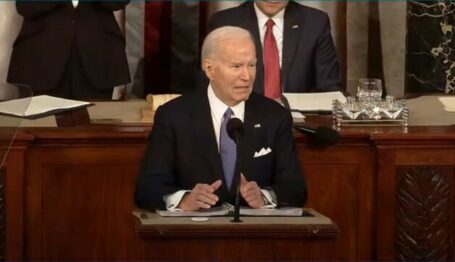Labor Watch
Big Labor’s Decline and Left Turn: Membership Decline
 By 1979, when Lane Kirkland succeeded George Meany as head of the AFL-CIO, fundamental changes to the economy had led to a decline in the unionized share of the private economy that continues to this day. Credit: Bernard Gotfryd. License: https://bit.ly/4b2FyHz.
By 1979, when Lane Kirkland succeeded George Meany as head of the AFL-CIO, fundamental changes to the economy had led to a decline in the unionized share of the private economy that continues to this day. Credit: Bernard Gotfryd. License: https://bit.ly/4b2FyHz.

Big Labor’s Decline and Left Turn: The Government Workers Rise and Labor’s Center Falls (full series)
A New Power Rises | Labor’s Private-Sector Left | Causes of the Long Decline
A Trade Unionist in the White House | Membership Decline
Membership Decline and Labor’s Finest Hour in Foreign Relations
Lane Kirkland, head of the AFL-CIO from 1979 through 1995, was cut from the mold of his predecessor and former boss, George Meany. A former merchant mariner who became a policy analyst at the AFL and wrote speeches for Democratic national candidates, he was a New Deal/Great Society liberal in domestic and economic views. But like Meany and unlike Reuther, Kirkland was a staunch Cold Warrior. As Meany’s chief lieutenant, Kirkland had supported the AFL-CIO’s decision to refuse its endorsement to 1972 Democratic nominee George McGovern and was a founding member of the second Committee on the Present Danger, an anti-Soviet coalition that would place many members in foreign policy roles in the Reagan administration (and which would, after 1979, count Reagan as a member).
Kirkland’s record at the AFL-CIO was defined by the Long Decline in union membership and union density, the proportion of the workforce consisting of organized workers. When he took office in 1979, 24.1 percent of wage and salary workers were union members. When he left office in 1995, 14.9 percent were. In raw numbers, union membership fell from just under 21 million to 16.4 million. (All figures are from the UnionStats.com database published by Barry T. Hirsch, David A. Macpherson, and William E. Even.)
The Long Decline changed whom the labor movement represented. The union density of the government sector remained largely stable over Kirkland’s tenure, with membership density actually rising from 37.0 percent to 37.7 percent. Adding in those government-sector workers who were not union members but were subject to a union contract, the percentages were 44.2 in 1979 and 43.5 in 1995. Even as total union membership declined by over 4 million, government-worker union membership rose by over 1 million.
The Long Decline fell entirely in the private sector, which was affected by the trends in economic and political developments discussed earlier. Over Kirkland’s tenure at the AFL-CIO, private-sector union membership fell by over 5.5 million from 15.1 million to 9.4 million, and private-sector membership density fell from 21.2 percent to 10.3 percent.
Even as his domestic influence and membership waned, Kirkland would lead the AFL-CIO to a key role in the closing days of the Cold War. With assistance and federal funding from Senate Republicans, normally a bête noire of Big Labor, Kirkland’s AFL-CIO led an international campaign to support the independent, anti-government, and anti-Communist free trade union movements in the Communist bloc. More controversially within the labor movement, Kirkland also hesitated to oppose the Reagan administration’s policies in Latin America. The Washington Post even quoted an aide to Sen. Orrin Hatch (R-UT) crediting Kirkland thus, “The AFL-CIO in general takes foreign policy positions to the right of Ronald Reagan.”
Kirkland or his defenders could argue that American trades unionism’s finest, most public-spirited hour came in the late 1980s. With American government backing through Kirkland’s AFL-CIO, Eastern European trades unions—most famously Poland’s Solidarność (Solidarity)—campaigned against the Communist regimes that ruled the “captive nations” of the Warsaw Pact. By 1989, their mass movement was powerful enough to topple Communist regimes no longer able to count on Soviet military force for their continued power, and in 1990 Solidarność leader Lech Walesa took office as the first democratically elected president of Poland.
With the Wall Fell Labor’s Center
All was not comfortable in Lane Kirkland’s House of Labor given the AFL-CIO head’s anti-Communism. A rising faction of unionists, led by Sixties activists who had burrowed into the labor movement and risen to power driven by the growing share of government workers in Big Labor’s membership wanted a change from the Meany-Kirkland era of center-left consensus welfare-state and strong-defense policy to open socialism at home and retreat abroad.
When Kirkland announced his intention to retire in 1995, the rising leftist faction pounced. Kirkland named his protégé, Thomas R. Donahue Jr., interim president of the union federation. A Catholic trade unionist who had worked first under Meany and then as Kirkland’s number-two man, Donahue offered continuity. But at the 1995 general convention, Donahue was unseated by the radical faction led by Service Employees International Union head John Sweeney, a card-carrying member of the Democratic Socialists of America (according to contemporary reporting) from a union with strong government-worker membership and the backing of government-worker union boss Gerald McEntee.
Sweeney took office vowing to reverse the Long Decline and revitalize Big Labor as a political force on the American Left. In the coming decades, he would prove successful in one-half of those aims.



